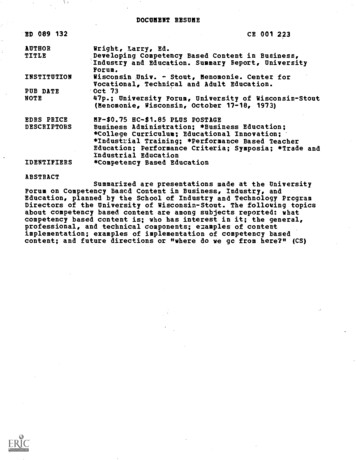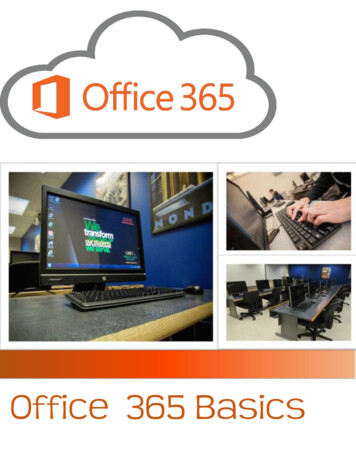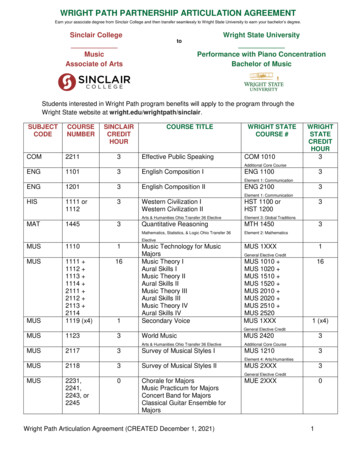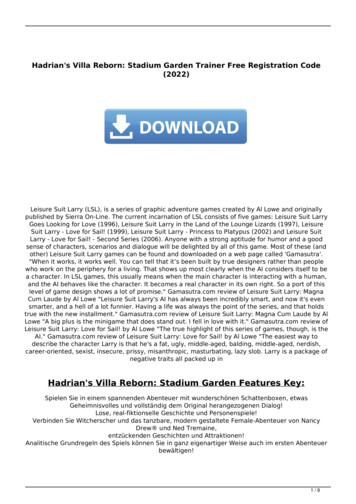
Transcription
DOCUMENT RESUMEED 089 132AUTHORTITLEINSTITUTIONPUB DATENOTEEDRS PRICEDESCRIPTORSIDENTIFIERSCE 001 223Wright, Larry, Ed.Developing Competency Based Content in Business,Industry and Education. Summary Report, UniversityForum.Wisconsin Univ. - Stout, Menomonie. Center forVocational, Technical and Adult Education.Oct 7347p.; University Forum, University of Wisconsin-Stout(Menomonie, Wisconsin, October 17-18, 1973)MF- 0.75 HC- 1.85 PLUS POSTAGEBusiness Administration; *Business Education;*College Curriculum; Educational Innovation;* Industrial Training; *Performance Based TeacherEducation; Performance Criteria; Symposia; *Trade andIndustrial Education*Competency Based EducationABSTRACTSummarized are presentations made at the UniversityForum on Competency Bascd Content in Business, Industry, andEducation, planned by the School of Industry and Technology ProgramDirectors of the University of Wisconsin-Stout. The following topicsabout competency based content are among subjects reported: whatcompetency based content is; who has interest in it; the general,professional, and technical components; examples of contentimplementation; examples of implementation of competency basedcontent; and future directions or nwhere do we gc from here?tt (CS)
U.S. DEPARTMENT OF HEALTH,EDUCATION & WELFARENATIONAL INSTITUTE OFEDUCATIONTHIS DOCUMENT HAS BEEN REPRO.DUCED EXACTLY AS RECEIVED FROMTHE PERSON OR ORGANIZATION ORIGIN.ATING IT. POINTS OF VIEW OR OPINIONSSTATED DO NOT NECESSARILY REPRE.SENT OFFICIAL NATIONAL INSTITUTE OFEDUCATION II,OSITlyN OR POLICY.717)4PM\-62Center For Vocational,Technical And Adult Education UW-Stout Menomonie, Wisc. (54751)
Summary ReportDr. Larry Wright, EditorUniversity of Wisconsin-StoutMenomonie, WisconsinOctober 17 and 18, 1973University ForumDeveloping Competency Based Contentin Business, Industry and Education
University Forum - DevelopingSummary Report:Competency Based Content in Business, Industryand Education, University of Wisconsin - StoutMenomonie, Wisconsin, October 17 and 18, 1973.Dr. Larry Wright,EditorThe University Forum on Competency Based Content in Business, Industry, and Education was planned by the School of Industry and Technology Program Directors,U.W.-Stout:Mr. Robert Behling, Program Director, Business Administration,U.W.-StoutDr. James Bensen, Undergraduate Program Director, Industrial ArtsEducation, U.W.-StoutDr. Harold Halfin, Graduate M.S. and Ed.S. Program Director, VocationalEducation, U.W.-StoutDr. Ray Keil, Undergraduate and Graduate Program Director, IndustrialTechnology, U.W.-StoutDr. Philip Ruehl, Undergraduate Program Director, Vocational andTechnical Education, U.W.-StoutDr. Larry Wright, Graduate Program Director, Industrial Education,U.W.-Stout
Editors IntroductionThis conference was conceived in May of 1973 by Dr. James Bensen andyour editor as they reflected in the St. Louis Airport about the Associated Organizations for Teacher Education (AOTE) conference on Redesigning Teacher Education, which we had just attended.The American Council on Industrial Arts Education had sponsored ourvisit along with eight other participants to the AOTE conference. Wewere looking for some avenue of evidencing our appreciation to the council,to our University, and to the profession for providing this stimulatingexperience.We had both been struck by the need for a forum to consider the competency based approach in more detail, and were of the opinion that togather a group of people together to consider the topic couldn't waituntil the next national meeting of one of our professional associations.Accordingly, we were delighted when our School of Industry and Technology Department Chairmen and Program Directors Council at Stout agreedto sponsor the event in October.Later, our Center for Vocational, Technical and Adult education agreed to support the writing of this summaryreport of the Forum.The following topics about competency based content are among subjects reported in this summary:1.2.3.4.5.6.What is it?Who has interest in it?The general, professional and technical componentsExamples of content for implementationImplementing competency based contentWhere do we go from here?It has been an interesting and professibnally rewarding experienceto listen to nine hours of audio tapes and to summarize the presentationsmade. Each speaker was invited to read the preliminary draft of the summary of his remarks and make any changes he might believe appropriate.In our interest in conserving paper, we hope to have preserved the essentials of the presentations made.Larry Wright, EditorUW-Stout, November, 1973
TABLE OF CONTENTSPageEditor's Introduction - Larry WrightTable of ContentsiiList of FiguresivCompetency Based Content - What is It?Philip Ruehl1Competency Based Content - Who has Interest in It?Business and Industry - Joseph D. Koch2Education - Stanley E. Brooks2Competency Based Content - Interactive Group DiscussionsJames Herr4Art Muller4Henry Thomas5James Collier5Marvin Kufahl5Ray Hansen6Tom Baldwin6Stan Johnson---- 6How May an Administration Support a Competency BasedCurriculum? Earl Gierke6Competency Based Content - The General, Professional andTechnical ComponentsHarold Halfin7Orville Nelson8Competency Based Content - Mini Reports on the ProfessionalComponentBusiness and Industry - Richard Seitz11Education - Franzie Loepp14ii
Table of Contents (Cont.)PageCompetency Based Content - The Technical ComponentContent Organizers in the 1960's - Larry Wright17Examples of Content for Implementation of Competency BasedInstruction - Dean Hauenstein19Implementing Competency Based ContentBusiness and Industry - Joseph Koch and Richard Seitz.30The Technical Component - Franzie Loepp3?The Educational Component - Stanley Brooks33Competency Based Content - Where Do We Go From Here?Philip Ruehl35William Amthor36John Entorf36Robert Rudiger36Paul Menges37Zenon Smolarek37Jack Sampson38University Forum Summary - James Bensen39Selected Significant References40iii
LIST OF FIGURESFigurePage1The General, Professional and Technical Components2Levels of Technical Competencies103Key Elements of Our Ideal Training System134Content Organizers - 1960's185Fifteen Innovative Programs of the 1960's Relatedto Industrial Arts20Content Organizers Found in the Fifteen Innovative.Programs of the 1960's.217Diagram of School Programs258Educational System269Industrial Arts Subject Matter2710Development Model2811Individualized Instruction2912Credit System316iv.9
Competency Based Content - What is It?Dr. Philip Ruehl, Assistant Dean, School ofIndustry and Technology, U.W. -StoutCompetency based content is a very logical approach to solving curriculum problems related to content.The first step to achieving a competency-based program isobviously to identify the content.Content is selected from a valid and complete list of preciselydefined knowledges, skills and attitudes.Content is derived from a detailed job description and this isthe basis for providing educational experiences for a student aspiring to enter a given job.In a competency based program the competencies required formthe base for evaluating instruction.Competency based content has equal value for industry, businessor education in that the starting point is the detailed job description.In four-year programs there is (1) a professional component,(2) a general studies component and (3) a technical component.Significantly interwoven with these three components are thehuman and interpersonal relations.The required step after job description is analysis - eithertask or conceptual or both.Who should do a task analysis? The persons responsible fordirecting the program.They should include consultants and peopleon the job in making their analyses.Three Challenges:(1) Analysis must include those on the jib.valid fashion by arm chairs.It cannot be done in a(2) The analysis is complete when we have identified the elements.We need to blend and integrate into the whole. We function asindividuals and should function as a painter rather than one whopaints by numbers.(3) We must plan for maintenance of the content.How do you keep itup to date? A means must be found and would include on the jobexperiences, careful observation and continuous evaluation.1
Competency Based Content - Who Has Interest in It?Business and Industry:Mr. Joseph D. Koch, Manager, Audio-Visual Services,General Motors Institute, Flint, MichiganCompetency based content. Who has interest in it? No one has interest in it - unless he is interested in (1) what the student must learn(2) when the student has mastered it and (3) how to get the student to anappropriate mastery level.Those in education, industry, business, sales or service have to beinterested in competency-based content because it provides controls. Ifwe are interested in learner output, we must have these controls to produce the output.Following is the learning needs equation:"MCROCR" plus content .learning.In words, motivation, plus concentration, plus reaction, plusorganization, plus comprehension, plus repetition, plus content equalslearning.Content must be accurate, current, fit the environment in which thestudent will work, flow smoothly and be acceptable to the student. Content must reinforce each of the elements of the equation.Content must be based on output and output that can be measured.tent controls and gives organization to the education and/or trainingactivity.Con-My experiences with competency based content include the training oflocomotive repairmen who ordinarily handled low tolerance, large heavyequipment to service and repair Titan II Balistic missile guidance equipment which required high tolerance, and was small, delicate equipment.We identified the desired output, furnished competency-based content toguide and control the training and trained toward that end. We wereextremely successful.One of our immediate problems is to prepare all General Motors personnel in the use of the metric system.Knowing the required output,competency can be assured through educational technology.Who has interest in competency based content? It better be all of usif we are interested in controlling the output learning.Education:Dr. Stanley E. Brooks, Professor, State UniversityCollege of Buffalo, Buffalo, New YorkA national study was undertaken to ascertain who really is involvedin competency based teacher education within the field of industrial arts.Each department chairman, head or dean in The Teacher Education Directoryreceived a simple one-page questionnaire. Of the 198 institutions whichwere contacted, replies were received from 140, or 70 percent.241
1.Is your staff currently studying competency based teacher education? 72 yes; 68 no2.Is your staff engaged in an operational competency based teachereducation program? 34 yes; 106 no3.Where is your primary focus in terms of the implementation?Individual courses - 24; within professional sequency - 25;technical sequence - 18; or general education component - only3.A4.What is the degree of staff commitment?staff - 30; one staff member - 105.How is the competency based teacher education effort focused?Under graduate - 50; graduate level - 2; both - 166.What stage of development are you at:Cautiously watching - 12;we are beginning - 48; well along - 8; completed - 3.Very few people have completed a program that is ready for obser-Total staff - 28; fewvation.7.What professional meetings have your staff attended? ACCTE 14; ASCD - 9; ATE - 4; AERA - 1; AACTE Clinics - 14.These meetings featured major programs relating to competencybased education. We need to go to these meetings and see whatis going on in other disciplines.8.What degree of agency involvement ought to be part of competencybased teacher education?Associations can be excellent allies.However, some seem unalterably opposed to any assessment or evaluation that mightendanger one's tenure. We may want to consider:1.2.3.What are the competencies required to enter the teachingprofession?What are the competencies required to receive continuingcertification?What are the competencies required to stay in the profession for one's professional life?Public school industrial arts teachers involvement:some - 31; considerable - 9; total involvement - 1none - 10;Professional industrial arts association involvement: none 14; some - 22; considerable - 6; total involvement - 1Industrial arts college students:able - 14; total involvement - 0Public school administrators:6; total involvement - 0none - 15; some - 29; considerable -Public school guidance personnel:able - 5; total involvement - 0.3none - 5; some - 33; consider-none - 22; some - 14; consider-
Interdisciplinary departments in college:considerable - 16; total involvement - 3none - 12; some - 16;Lay advisory groups: none - 18; some - 17; considerable - 5;total involvement - 0State Education Departments:4; total involvement - 09.10.none - 1; some - 5; considerableCan you identify a contact person directly involved?Are there resources available?yes - 31y s - 6Who in education has interest in it? The study found a good deal ofinterest in competency based content and a few institutions who have someoperational programs.(Editor's note:Dr. Brooks indicated a willingnessto make more details available to those who requested them from him).Competency Based Content - Interactive Group DiscussionsThe following is a brief report of statements made in the eight interactive discussions groups.By the time the last two groups were asked toreport, the points they had made had already been presented by other discussion leaders.Dr. James Herr, Associate Professor,Graphic Communications Department, UW-Stout1.In education we leave a lot of things to chance.Competency basededucation is designed to have things happen on purpose.2.We, as a profession have much work to do since we are not now in agreement as to what competencies we require of our students.3.We need to have a mechanism for keeping competencies current and foradding appropriate new ones to the lists.4.Attendance at professional meetings, reading professional and tradejournals, participation in in-service meetings all may contribute tokeeping competencies and competency lists updated.Dr. Art Muller, Associate ProfessorMaterials and Processes Department, UW-Stout5.We need to know who determines what the required competencies should be.6.Once competencies are developed, how can we prevent a break down intheir implementation?7.The competency-based approach may be related to contract educationwhere private agencies agree to meet prescribed performance standards.4
Dr. Henry Thomas, Associate ProfessorMaterials and Processes Department, UW -Stout8.To determine competencies one must have some source of content inmind and a philosophical base for competency development.9.Goals in industrial education include both general industrial artseducation and more specific technical vocational-industrial education.10.In looking at what competencies may be required for work-role success,we need to look not only at those who are successful Performers butalso at those who may have tried but were not successful.11.To what level do teachers need to have technical competencies? Doteachers need competencies to the industrial work-role performancelevel?12.In competency based education are we measuring the obvious to the extreme - to the neglect of the important but less-easy-to-measure competencies?13.In use of the competency based approach, both the students and theteacher know at all times where they are in relation to the goals tobe achieved.14.There is a danger of leaving out the human part of educationin the competency approach since it is difficult to describeand measure.Dr. James Collier, Associate ProfessorEnergy and Transportation Department, UW-Stout15.Some questions include: What is involved in developinga competency based program? What are the implications?What about the feelings of staff?Is it a difficult procedure?16.What about graduate studentsemploying a competency basedtution? How will credits orthey transfer if they will?17.Is the evaluation system for a competency approach so complex as topreclude success of the approach?18.It seems obvious thatl it would take a real commitment of time and resources to develop a competency system.who want to transfer from an institutionsystem to a non-competency based insticompetencies be evaluated? and, how willWhat will be on the transcript?Mr. Marvin Kufahl, Associate ProfessorMaterials and Processes Department, UW-Stout19.Are there special problems of motivation in a competency system?5
Mr. Ray Hansen, InstructorIndustrial Management Department, UW-Stout20.Can a competency based system be developed for general education?21.What is the climate in secondary education with respect to competencybased systems? Are we preparing teachers who will not be able to fitinto employment situations that exist?22.Does the competency based system lend itself to modular scheduling?23.The next step for each person is to start evolving his instructiontoward a competency base.24.Attainment of competencies possibly will take a period either longeror shorter than the present 4-year programs, depending on individualdifferences in students and teachers.25.In the light of the many questions raised about competency based education, perhaps we could take a positive view that it can be accomplished.Each problem raised deserves an answer. There is much roomfor research and experimentation.Dr. Tom Baldwin, Assistant ProfessorEnergy and Transportation Department, UW-StoutMr. Stan Johnson, InstructorBusiness Administration Department, UW-StoutQuestions raised in these two groups were presented in other groupsby those who had already reported.How May an Administration Support a Competency Based Curriculum?Dr. Earl Gierke, Curriculum Coordinator.Division of Academic Affairs, UW-StoutThese comments are related to how we in administration at UW-Stout cansupport competency based education.Support of the administration is a requisite to an implemented program.Support must be in various forms including encouragement to the faculty andresource allocation.Beyond that it needs a structure.Basic to our structure at UW-Stout is the separation of instruction and program. Programs atStout are headed by Program Directors who may draw en the instructional resources of the total university as opposed to the traditional approach ofprograms being oprated by departments with somewhat vested interests.Faculty support is also required.This may come from in-service acProgram Directors use transdisciplinary committees to identifycompetencies needed within their program. The whole question of creditsor some other recognition for experiences either on-campus of off-campusis required.tivities.6
SerVice unit support is also required through registration, advisementand placement of students.Support of students is also needed.flexible in looking at newer approaches.They Seem to be among the moreSupport of the system of which we are a part is also needed. We arenow in a state-wide University of Wisconsin system. Some education isneeded here to allow this newer approach to competencies to be tried outat the same time reporting our activities in a system to make it compatiblewith other units in the system.Another ingredient is the willingness to experiment and the willingness to make a few mistakes.With these ingredients of administrative support, a competency basedapproach can be tried and hopefully will be successful in providing moreefficiently to meet the needs of our students.Competency Based Content - The General, Professional and TechnicalComponents.Dr. Harold Halfin, Director, Center for Vocational,Technical and Adult Education, UW-StoutAttributes of a competency based teacher education program include:1.Sharper focus on objectives2.Individualization of responsibility for learning3.More attention to individual differences and learning styles4.Learning more directly related to the objectives5.Individual assessment and feedback6.More effective integration of theory and practice7.More direct relationship between what is taught and what is doneon the job8.Evaluation focused not only on what the learner knows but in howhe performs in actual teaching situations9.Change in the role of the teacher as a facilitator or manager oflearningAttention directed toward the changing role of the teacherResearch on competency based teacher education has been limited tothe professional component of what the teacher does. Little attention has7
been given to the substantive (or technical) component and little attentionhas been given to the competencies required for the general component.However, the three must beintegrated to provide a comprehensive pre-servicecompetency based program for teacher preparation. To do this we must giveattention to role-relevant education.Role-relevant education involves the identification of the variousroles which the teacher performs while on the job as well as the roleswhich he performs during the hours he is not involved in the teaching act,such as outside the school classroom and outside the school.The three roles have already been mentioned:(1) his role as a professional(2) his role as a master of substantive content(3) his role as a generally educated member of societyOnly when competencies in each of these work-role elements is integratedwithin the individual can we claim to have had a competency based program.Competency Based Content - The General, Professional and TechnicalComponentsDr. Orville Nelson, Research Specialist, Centerfor Research and Educational ImprovementWith the introduction to the role of the teacher as presented by Dr.Halfin, we have developed a model with the learner and the learning environment as the focal point. The competencies to be developed in the teacher should be designed to impinge upon that focal point, Figure 1. Theactivities of the professional teacher are directed at designing, establishing and maintaining this environment.The technical competencies may be acquired by formal study and bywork experience in business and industry. This may depend upon the levelat which one is teaching and the type of institution in which one is working.The professional competencies are used to draw from the technicalcontent in presenting, managing, and evaluating the learning experiences.General education provides the context, principles and the backgroundwhich give the individual the resources and the flexibility to be able toexplain and to generalize the concepts he is teaching. Note that the arrowsindicate the importance of the interaction between these three components.When the individual performs these three roles on the job, he performsthem in an integrated manner.Look at the second model, Figure 2.The cone in the center illustratesthat technical competencies must be performed at least to the applicationlevel of the cognitive domain to have an effective teacher. Certainly inmany areas the teacher must perform them at higher levels such as analysis,8
19
.,.s; *t,,Linasam-leohauesemaner.m.-'1. znsolurnrqie: ,rnsmseizor:7i:.\ *ImIseircvmsze--lorogyairomoszlem.-- nencroritop.777 etwAsszasa.:A.1171kAXX."',4.0F \la; , ,,.,I1,agotzENESEIBMILIm.0111110111101411M911 0.113111ilek.A.V.%-rs.%,:.v.rv.:arn. .-TMINSLIEWIIINIAIII{.II(4.;,.#A:I\.I 7 E.4 C --2-"VarallIMMIXDOVEMETfauasissmaingetom - ,Aneaseara .:A.,,.sc.,1li(,.,./41s , .,:anc ; .04,:emersari-,-,7,.,,s,\ r.,d100/1P"-I .riL imgra.-nim.v. .6MSZI,ZICI-02LdlealIND CIVIAM -Q311111110k 11111113Wi\414112zWATIQb.017'liftliZzotezza Asersgigislar:FerVOFigure 210
synthesis and evaluation. He must also be able to perform at various levelsin the affective and psychomotor domains.The second cone illustrates that the professional and technical rolesfunction in an integrated manner. This would seem to require analysis,synthesis and evaluation of the discipline, programs and students.The truncated cone is meant to symbolize the greater flexibility whichgeneral education provides.At the synthesizing level the individual willhave more knowledge and skills to draw upon. He can develop richer learningexperiences and manage the learning environment more effectively. At theevaluation level he has more approaches and techniques to use in evaluating outcomes of programs and students.Each of these three components, the professional, the general andthe technical must be identified and each must be taught so that the individual functions in his teaching role work in an integrated way.Competency Based Content - Mini Reports on the Professional ComponentBusiness and IndustryMr. Richard Seitz, Staff Specialist, Management Education,General Motors Institute, Flint, MichiganI've heard people question whether competency based instruction ispossible.I want to assure you that it is possible to identify content andplace it in a competency based format.The first step as shown on this diagram is to find out the mission oftraining.That is, what is the student going to do when he or she finishesthe training? Only with knowledge of the mission goal for the training isit possible to develop competencies that will bring the goal about.Typical questions are: What is the mission goal? Who is to performWho says so? What is the student to do upon completion? Based onthese questions, one can analyze the tasks into outcomes or accomplishment.With the outcomes in hand, we determine when these outcomes are being met.In other words, what are the standards or the competency level? When wehave looked at these questions, then we can turn attention to instructionaldesign objectives and develop instructional strategies.it?Our mission at GM is to build a car.To succeed, each job must contribute to the mission.Each job is therefore broken down into its jobaccomplishments and standards. These form the basis for the competencybased content needed to assure that each person assigned to a job willbe given training to do the job.We develop mastery and pre-assessment.We must not let the students do over those things in which they are already competent.Students who can meet the mastery objectives of a givencourse should not have to go through that course.If one does not have the mastery, we send them through a processingsystem and this is where we use the competency based content to produce11
the mastery to the level required at the output which is an input into thereceiving or using system.Who is going to say what a 7th grader needs to know when he gets outof industrial arts? Nobody seems to know.If this is true, we can't startthe instructional design process. We have to identify what he must knowwhen he is finished with the instruction. Only then can relevant systematic,competency based instruction be developed.Competency based content is control.The student must be able to applywhat we are taught.It might be nice to know Mazlows Hierarchy of Needs butthe foreman on the job must be able to handle the person who comes on thejob in the morning in a drunken condition. Unless we can solve the dailyproblems with which we are confronted on the job, the instruction is not relevant. The same is true with teachers; if a student kicks the teacher,what does the teacher do? He doesn't recite Mazlow's Hierarchy of Needs tothe student.Another problem is, having found the individual to be competent, oneyear later he isn't doing what we taught him. Obviously, something hashappened to the competency level. We must manage the system so that thepersonnel in it function the way we want them to. Unless there is a rewardfor the output on some kind of a continuous basis, we can't expect the desired performances.In many cases, it is more advantageous to make studentshappy than it is to teach them what they need. New teachers find this outin one hour after entering the classroom.Who has control over the teachersand the environment? The principal? The superintendent? We better findout because unless we have a management system, we can't expect or assuredesired output.Let me give you an example! A big food chain found a problem with thecheck-out of groceries.If an unmarked item goes by, the cashier rings itup on the basis of what is thought to be the best price. Do we need to teachthe cashier how to find out the correct price? No! The cashiers know how."The customers get mad if I leave to locate a price." If the manager iscalled to get the correct price, he gets angry. "I am verbally punished ifI call him." So, "I found out the behavior isget them through the line."The check-out girl was competent when she finished learning. What happened?The environment didn't support the training! We must set up competencybased content and make it work by rewarding for it through management.We can say we want to set up a competency based system and if we do thisthrough a management system it will happen.It will happen with a minimumof training.Let me give an example: My job is instructional technologist.I deI set up a program and ran it through several pilots.It seemed to work exceptionally well.I turn the program over to the teaching staff. Six months later I looked in on a class and I can't recognizeIt has disappeared.thr2 content.I asked why it wasn't being used, thetJacher said, "I can't teach that way." At this point, we will probablydecide to replace that teacher because our goal is student competency andwe know that the original program design assures us of that. We have foundsign instruction.12
'too ic-;instriictional:Thjectives andInputIF00,-IHCI:.ANIINIMPFigure Key Elements Of Our Ideal Traininli SystenProcesin
Content is derived from a detailed job description and this is the basis for providing educational experiences for a student as-piring to enter a given job. In a competency based program the competencies required form the base for evaluating instruction. Competency based content has equal value for industry, business











